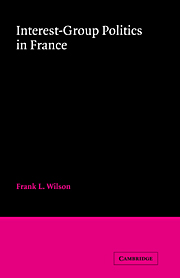Book contents
- Frontmatter
- Contents
- List of figures
- List of tables
- Acknowledgements
- 1 Introduction
- 2 Alternative views of interest-group politics in western democracies
- 3 Interest groups and politics: the non-occupational groups
- 4 Major interest groups: the occupational groups
- 5 Structures of interest-group politics
- 6 Interest-group actions
- 7 Interest-group leaders' attitudes toward interaction with government
- 8 The place of interest groups in French politics
- 9 The French experience and interest-group theory-building
- 10 Conclusions: interest groups and representative democracy in France
- Appendix A Questionnaire
- Appendix B List of groups included in interview sample
- Notes
- Index
2 - Alternative views of interest-group politics in western democracies
Published online by Cambridge University Press: 05 January 2012
- Frontmatter
- Contents
- List of figures
- List of tables
- Acknowledgements
- 1 Introduction
- 2 Alternative views of interest-group politics in western democracies
- 3 Interest groups and politics: the non-occupational groups
- 4 Major interest groups: the occupational groups
- 5 Structures of interest-group politics
- 6 Interest-group actions
- 7 Interest-group leaders' attitudes toward interaction with government
- 8 The place of interest groups in French politics
- 9 The French experience and interest-group theory-building
- 10 Conclusions: interest groups and representative democracy in France
- Appendix A Questionnaire
- Appendix B List of groups included in interview sample
- Notes
- Index
Summary
Much of the recent theoretical writings on interest-group politics has centered on the discovery or definition of appropriate models of interest-group/government interaction. Out of these writings have emerged a number of competing ideal-type models of the relations between groups and government, notably pluralism, elitism, and, most recently, neo-corporatism. Many of the attempts to apply these interest-group “theories” to real world practices have amounted to little more than mechanical measuring of which of the models most closely corresponds to observable actions and structures in particular countries. While this issue is an important one, such studies often result in the discovery of a mixture of elements from two or more of the models. They offer little explanation of why the particular patterns exist in the real world and why they are found in hybrid forms rather than more closely resembling the theorized ideal types.
In this chapter, I will review the principal characteristics of four major models of interest-group/government interaction: the pluralist model; the elitist, neo-Marxist model; the neo-corporatist model; and a protest model. As already noted, there is disagreement among students of French politics as to which of these models most closely corresponds with the reality of contemporary French politics. My own conclusions are that the pattern is a mixed one with elements from each of the four alternative models. This blend is not the product of an interim stage in the progression toward one of these ideal types but a permanent feature of interest-group/government relations in France.
From the theoretical standpoint, the more important questions probe why the particular forms of interest-group structures and activities found in France are there.
- Type
- Chapter
- Information
- Interest-Group Politics in France , pp. 17 - 47Publisher: Cambridge University PressPrint publication year: 1988



